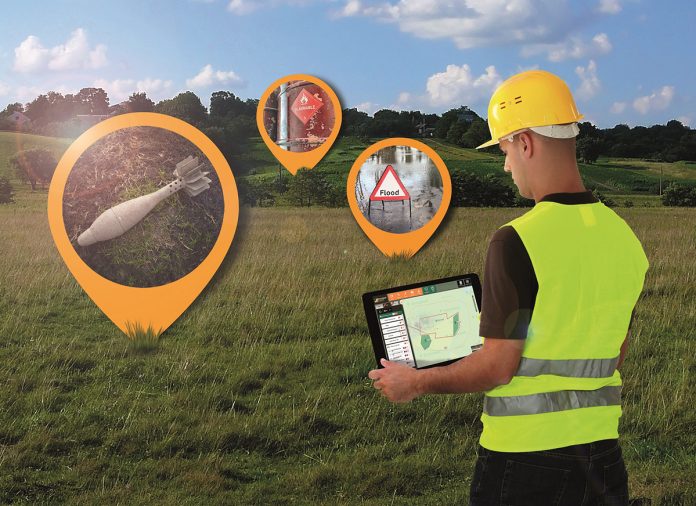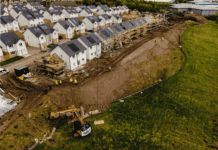With more developments taking place on brownfield sites, environmental risk assessments are becoming increasingly important to ensure schemes avoid potentially nasty surprises. Chris Loaring, Head of Consultancy at Argyll Environmental, takes a look
If you are about to purchase a new site or property, whether for refurbishment or a completely new redevelopment project, it’s important to do your research to make sure the site isn’t bringing with it any environmental hazards that may have an impact on the delivery of your project.
For example, do you know what the site has been used for in the past? If its brownfield land, have the correct investigations – and potentially remediation works – been carried out to rid it of any unsafe contaminants? Does the site have any risk of flooding? Could it be susceptible to any ground stability hazards, such as sinkholes or subsidence?
The first difficulty with risks such as these is that what you see is not what you get: the vast majority of problems are either below the ground’s surface or not imminently apparent to the naked eye.
We recently advised about a town centre retail property that was in great condition, apart from the buried remains of a former gasworks that turned out to be severely contaminated. This would never have been found without carrying out an environmental investigation – or until the toxins started leaking into the neighbouring river further down the line.
With more development projects taking place on designated brownfield sites, the risk of discovering contaminated land is potentially higher. While in most circumstances associated risks may be relatively low – or remediation has already taken place – there is the possibility that it could present a risk to health or affect local water sources or ecosystems, depending on what the contaminant is. Investigation at the outset is always recommended.
Is your project at risk?
Before embarking on any development or land purchase transaction, it is vital to ensure that the correct due diligence checks are carried out to find out whether any hazards are apparent and, if so, to determine what it means to your project (and legally, what needs to be done to mitigate the risk).
An environmental site assessment carried out by a specialist consultant will identify any potential risks that could impact the development, both in the immediate transactional timescale and in the long-term future.
Risks highlighted can be anything from potential unexploded ordnance, flood risk or ground instability through to land contaminants that may be present as a result of past industrial activities, such as mining, chemical production, manufacturing or tanneries, to name just a few.
The starting point is information gathering and research. Here at Argyll, our team completes a full range of analysis services, from undertaking simple report reviews or accessing desk-based data reports to more hands-on physical site-based assessments.
By undertaking environmental due diligence at the outset, you can clearly understand any hidden risks and receive practical and relevant advice to help you protect your property, site or business – whether it’s from flooding, contaminated land or ground instability.
Accessing historical mapping data is another way of extrapolating information regarding past activities that took place on the land. For example, from viewing a historic map, you can quickly identify whether industrial buildings, quarries, factories or similar where situated in your location.
Both councils and a number of commercial providers hold a range of information on potential sources of contamination. Councils maintain registers to illustrate when legal action is taken on contaminated land and for those sites that may be contaminated. Both sources also hold data on historic land use, planning history, pollution incidents, details of closed landfill sites and site-specific reports on investigation and remediation.
Once thorough desktop studies have been undertaken, if a potential risk is identified, the next stage is typically to commission a Phase 1 site assessment. At this level of reporting, an environmental consultant will visit the site and carry out a physical site walkover to provide precise recommendations.
This helps build up a clear picture of the scale of risks, such as whether any contamination is present, and whether a programme of soil, water or gas sampling is required. It is only after actual samples have been taken and analysed that decisions can then be made regarding whether any remedial work may be necessary.
Ultimately, identifying that a plot of land may be affected by an environmental risk doesn’t mean the planned project is doomed; it does, however, require the implementation of a strategy to manage the identified risks in a correct – and sustainable – way.
It is also worth noting that a number of helpful guides are available, which are worth referring to. The Environment Agency has produced a useful guidance paper, which includes a detailed workflow of the steps that should be taken from risk assessment through to audit and remediation for contaminated land, while the Know Your Flood Risk campaign offers free guides on flood risk, resilience and recovery. DEFRA and the National Planning Policy Framework also offer a wide range of downloadable guidance papers.
Ultimately, responsibility lies with the land owner and developer to ensure that any development is carried out in a safe and sustainable way and that the land is appropriate for its intended use.
Undertaking the correct level of environmental rigour from day one will ultimately provide peace of mind too all involved – not only for today’s owner and developer, but to the future generations of occupants too.

Chris Loaring
Head of Consultancy
Argyll Environmental
Tel: +44 (0)845 458 5250
Twitter: @argyllenviro
Please note: this is a commercial profile.














